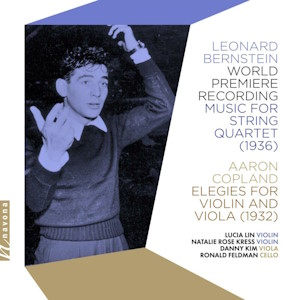
Leonard Bernstein (1918-1990)
Music for String Quartet (1936)
Aaron Copland (1900-1090)
Elegies for violin and viola (1932)
Lucia Lin (violin), Natalie Rose Kress (violin), Danny Kim (viola), Ronald Feldman (cello)
rec. 2023, Shalin Liu Performance Center, Rockport, USA
Navona Records NV6557 [18]
Listeners in the United Kingdom may tend to associate Leonard Bernstein with West Side Story, the overture to Candide, the film score for On the Waterfront, or the musical On the Town. Enthusiasts may think of Chichester Psalms or the Missa Brevis. I guess fewer people will be advocates of his three symphonies, the Serenade (after Plato’s Symposium) or the incidental music to Peter Pan. On the other hand, no one can ignore his achievements as a conductor, an educator, an author and a television personality.
Bernstein wrote precious little chamber music. That includes the early Piano Trio (1937), the Violin Sonata (1940) and the Clarinet Sonata (1942). Whilst still a student at Harvard University, he wrote Music for String Quartet. The Allegro vivace first movement (at least) was played through at rehearsal by members of the New England Quartet. Afterwards, Bernstein asked one of the violinists, Stanley Benson, if he would like to keep the manuscript score. It was preserved in the family music cabinet and was occasionally played during ‘at-homes’ but was then largely forgotten about. When it surfaced again, it was edited by Garth Edwin Sunderland. Around the same time, Sunderland located what seemed to be a second movement of this quartet in the Library of Congress. As the liner notes say, musicologists are certain that both movements are part of the same work: there are thematic references to the opening Allegro vivace in the concluding Andante (tempo di sarabande). Stylistically, the Quartet is eclectic. One can detect echoes of Bartók, Stravinsky and Hindemith, as well as George Gershwin. I found this an approachable and satisfying chamber composition. Whether it will successfully enter the repertoire remains to be seen.
Aaron Copland wrote the other piece here, the rare Elegies for violin and viola, when he was living in Mexico. Soon after premiere in New York on 2 April 1933, he withdrew the work, but mined it for Subjective, the fourth movement of his orchestral Statements (1932-1935). Copland scholar Howard Pollack writes that it is “virtually a note-for-note transcription”. According to the liner notes, the conclusion of Elegies is “the basis of the last portion of the third movement of Copland’s […] Symphony No.3”. This chamber piece is lugubrious and introverted, with much interplay between contrapuntal and harmonic textures. There is nothing that foreshadows Copland’s populist “American” works. If anything, this music nods more to Berg and Bartók than jazz or the “vernacular”. That said, it is interesting and rewarding.
The performance by the assembled quartet is outstanding. It gives an illuminating account of these roughly contemporaneous pieces by two of America’s most significant composers. The liner notes give a detailed overview of Leonard Bernstein, and succinct programme notes. This is a very short recital. In the good old days, we would have called an eighteen-minute recording an EP (extended play).
Be aware that neither work is in the “received” style of its composer. Even so, both are important and deserve to be in the repertoire to allow a greater understanding of their authors.
John France
Availability: Navona Records


















